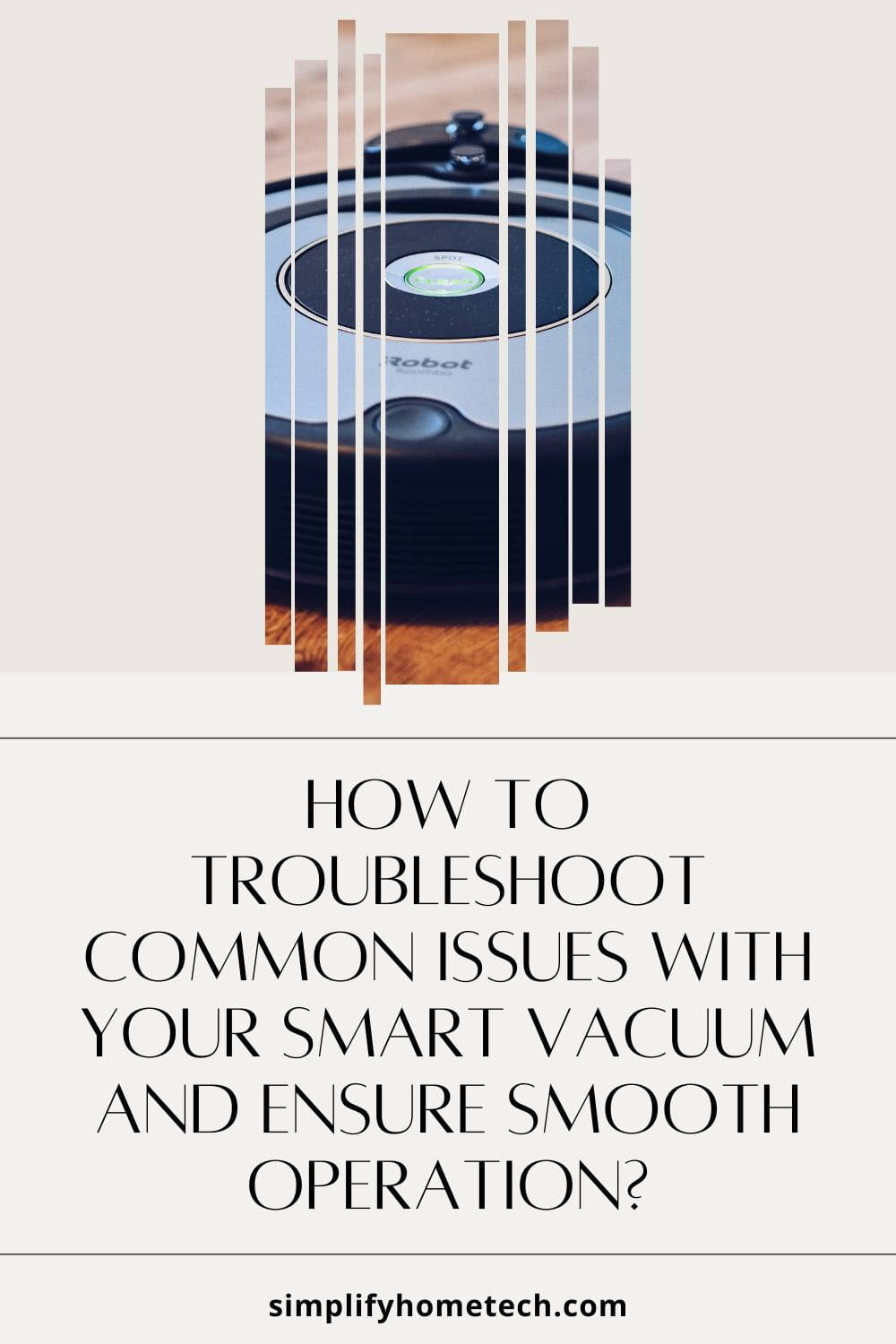Smart vacuums are amazing devices that can make your life easier by cleaning your floors automatically and efficiently. However, like any other device, they can also encounter some issues that can affect their performance or functionality. In this article, we will show you how to troubleshoot common issues with your smart vacuum and ensure smooth operation.
What is a Smart Vacuum and How Does It Work?
A smart vacuum is a robotic device that can automatically clean your floors without much human intervention. Smart vacuums are equipped with sensors, cameras, or lasers that help them navigate your home and avoid obstacles. They can also be controlled via a remote, an app, or voice commands. Some smart vacuums have advanced features like mapping, scheduling, mopping, or self-emptying.
A smart vacuum works by using its sensors and cameras to scan the environment and create a map of your home. Then follows a predefined or customized cleaning route based on your preferences and needs. It can adjust its suction power and brush speed according to the floor type and the level of dirt. Can also detect stairs, cliffs, or drop-offs and avoid them. When the battery is low or the cleaning is done, it returns to its docking station to recharge or empty its dustbin.
What are the Benefits of Using a Smart Vacuum?
Using a smart vacuum can offer you many benefits, such as:
- Saving time and energy. You don’t have to spend hours vacuuming your floors manually or worry about missing spots or corners. You can simply set up your smart vacuum and let it do the work for you.
- Maintaining a cleaner and healthier home. Your smart vacuum can remove dust, dirt, pet hair, allergens, and odors from your floors more effectively and frequently than you can. This can improve the air quality and hygiene of your home and reduce the risk of allergies or infections.
- Adapting to different floor types and situations. Your smart vacuum can handle different floor types such as hardwood, tile, carpet, or laminate with ease. It can also cope with different situations such as spills, stains, or clutter with its various cleaning modes and features.
- Integrating with other smart devices and platforms. Your smart vacuum can connect to your Wi-Fi network and app and allow you to control it remotely or schedule it in advance. It can also integrate with other smart devices such as speakers, cameras, or thermostats and platforms such as Alexa, Google Assistant, or IFTTT and enable you to create smart home scenarios or routines.
How to Troubleshoot Common Issues with Your Smart Vacuum?
To troubleshoot common issues with your smart vacuum, you can follow these steps:
Check the manual and the manufacturer’s website
The first step to troubleshooting any issue with your smart vacuum is to check the manual and the manufacturer’s website for any instructions, tips, or solutions. You can also look for FAQs, videos, or forums that may address your specific problem.
Check the power source and the battery
The next step is to check the power source and the battery of your smart vacuum. Make sure that the outlet is working, that the docking station is plugged in and positioned correctly, and that the charging contacts are clean and aligned. If the battery is low or defective, you may need to replace it or contact the manufacturer for a warranty claim.
Check the Wi-Fi connection and the app
The next step is to check the Wi-Fi connection and the app of your smart vacuum. Make sure that your Wi-Fi router is on and within range, that your smart vacuum is connected to the same network as your phone or tablet, and that your app is updated and compatible with your device. If you have trouble connecting or pairing your smart vacuum, you may need to reset it or contact the manufacturer for technical support.
Check the dustbin and the filters
The next step is to check the dustbin and the filters of your smart vacuum. Make sure that the dustbin is empty and inserted correctly, that the filters are clean and not clogged, and that there are no leaks or cracks in the dustbin or filters. If you notice any damage or wear on these parts, you may need to replace them or contact the manufacturer for a warranty claim.
Check the brushes and the sensors
The next step is to check the brushes and the sensors of your smart vacuum. Make sure that the brushes are clean and not tangled with hair or debris, that they are spinning freely and not blocked by anything, and that they are suitable for your floor type. Also make sure that the sensors are clean and not covered by dust or dirt, that they are not damaged or scratched, and that they are working properly. If you notice any damage or wear on these parts, you may need to replace them or contact the manufacturer for a warranty claim.
Check for any errors or alerts
The last step is to check for any errors or alerts on your smart vacuum or app. Some smart vacuums have LED lights, sounds, or voice prompts that indicate different statuses or problems. Some also have error codes that display on their screens or app. You can refer to your manual or manufacturer’s website for what these mean and how to fix them.
How to Prevent Common Issues with Your Smart Vacuum?
To prevent common issues with your smart vacuum, you can follow these tips:
- Clean and maintain your smart vacuum regularly. To keep your smart vacuum in good condition and performance, you should clean and maintain it regularly. This includes emptying the dustbin, cleaning the brushes, filters, and sensors, and replacing any worn or damaged parts. You should also update your app and software whenever there is a new version available.
- Use your smart vacuum properly and safely. To avoid damaging or overloading your smart vacuum, you should use it properly and safely. This includes following the manufacturer’s instructions and recommendations, choosing the right suction power and cleaning mode for your floor type, avoiding wet or sticky substances, and keeping your smart vacuum away from heat sources or water.
- Clear the floor and the obstacles. Before starting a cleaning session, clear the floor and the obstacles to avoid your smart vacuum getting stuck or trapped by them. Take away any cords, curtains, tassels, toys, or other objects that the smart vacuum can tangle or jam with. You can also put physical or virtual barriers to prevent your smart vacuum from entering areas that you don’t want it to enter.
FAQs
Here are some frequently asked questions about troubleshooting common issues with your smart vacuum.
Q: How often should I clean my smart vacuum?
A: The frequency of cleaning your smart vacuum depends on several factors, such as how often you use it, how dirty your floors are, and what kind of floor type you have. Generally, you should empty the dustbin after every cleaning session, clean the brushes and filters once a week, and clean the sensors once a month. You should also check the manual for any specific cleaning instructions for your model.
Q: How do I reset my smart vacuum?
A: The method of resetting your smart vacuum may vary depending on your model and manufacturer. However, a common way to reset your smart vacuum is to press and hold the power button for a few seconds until you hear a beep or see a light flash. You can also check the manual or the manufacturer’s website for more details on how to reset your smart vacuum.
Q: How do I update my smart vacuum’s software?
A: The method of updating your smart vacuum’s software may vary depending on your model and manufacturer. However, a common way to update your smart vacuum’s software is to connect it to your Wi-Fi network and app and check for any available updates. You can also check the manual or the manufacturer’s website for more details on how to update your smart vacuum’s software.
Conclusion
Smart vacuums are amazing devices that can make your life easier by cleaning your floors automatically and efficiently. However, like any other device, they can also encounter some issues that can affect their performance or functionality. In this article, we showed you how to troubleshoot common issues with your smart vacuum and ensure smooth operation. We hope that this article was helpful and informative for you. Happy cleaning!
You might also like,
How to Replace Filters and Maintain Your Smart Vacuum for Optimal Performance

